C4RD, London March - April 2009
Vane, Newcastle Upon Tyne April - June 2010
Ha Gamle Prestegard 16th April - 5th June 2011
E: info@vane.org.uk
W: www.vane.org.uk
“Nick Fox's Phantasieblume is a series of intricate paintings inspired by the Victorian cultural phenomena of Floriography, or, as Kate Greenaway's popular 1884 book called it, The Language of Flowers. Floriography was an intricate means of communicating hidden or forbidden passions by using different types of flowers as gifts. Fox's intimations of oppressed sexuality are embodied in painted glass panels that might initially look like intricate lacework doilies but, on closer scrutiny, reveal erotic glimpses. Steamy encounters emerge from the fine networks of entwined petals and tendrils. The acrylic paint is painstakingly layered and incised so that the overall, almost stained-glass effect, has the accumulative air of preciously savoured sensuality.”
Robert Clark
Exhibitions picks of the week
Saturday 8 May 2010
Please click here for more information on Phantasieblume and accompanying publication livepage.apple.com

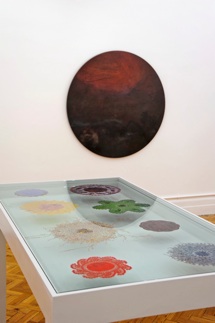
Central to Nick Fox’s painting practice is his fascination with narratives of desire. Often subversive, and made in combination with objects, drawings and context specific installation, the work takes the form of drawing and painting, installation, and intricately laboured Objet d’art. Fox’s practice is informed by disparate and sometimes contradictory reference points and layers of meaning.
“Nick Fox’s paintings are compounded of difference - complex and disparate layers of imagery and meaning borrowed from high art, domestic decoration and subcultural symbology. Referencing Neoclassicism, Victorian visual culture and contemporary pornography, they are simultaneously clear and elusive. They engage with the matter of paint, are painterly in execution and yet their surfaces are as un-‘painty’ as it’s possible to be [...]This is part of the system of concealment and disclosure which Fox uses as both the form and content of his works, and, uniquely, their process of production. [...] Built up slowly from layers of acrylic paint laid over glass sheets, this replaces the usual rewards of visible development, with deferred gratification and Fox finally delivers [...] fusions of fine art and craft which turn his works into exotic hybrids.”
Stephanie Brown, The Tuberose, the Incubus and Endymion from Nick Fox: Phantasieblume, co-published by AEN and C4RD, 2010
Building on the delicate relationship between fine art and craft, his visual research explores representational and material orthodoxies in painting languages though two symbiotic strands: a physical exploration of the narrative potential of the paint material and the exploration of visual and symbolic codes of romantic desire and explicit eroticism, reflected in historical pictorial systems and personal codes of concealment.
His seductive drawings, mirrored paintings and craft objects reveal an intoxicating blend of graphic sexual imagery and Victorian floriography, creating elusive narratives and unsustainable utopias. Fox’s imaginary landscapes are seductive, luring the viewer ever deeper. Drawing on a vast bank of sources, Fox transforms the found taboo image and context (of photo-reproduction porn or fashion) into one of intimate and emotive experience. Languorous male figures emerge from his sensual and craquelure surfaces while overlaid botanical imagery fuses a symbolic role to his themes of desire, longing and loss. These tantalising idylls and elusive narratives are often rendered in dark or overripe colour that, along with his painting process, create a toxic fog, an Eden after the fall, one where innocence has been banished.
Phantasieblume's explores the interrelations and contradictions between drawing and painting, fine art and craft, investigating the potential significance of deliberately blurring these boundaries.
Utilizing the traditional material of paint, Fox developed innovative ‘cutting’ technique: a labour-intensive process that signifies devotion. This enabled a new exploration of the contemporary currency, symbol and cultural meaning of longing, seduction, desire and romance. Applying layers of ink and acrylic paint directly onto glass, intricately cut, he created and exhibited a series of skins of paint, “drawings” and “paintings”, which subvert the traditions and expectations of those mediums.
Reference points include: Neo classical and Vanitas painting, Victorian visual culture, literature, craft, pornography and subcultural codes. Fox draws upon floriography, the secret language of flowers that was a Victorian cultural phenomenon using flowers as tokens to communicate hidden or forbidden pleasures within normative courtship rituals. Fox was also informed by the mechanics of underground courtship rituals where floriographic imagery was employed through a range of Fin de siècle Literature sources (Wilde and Huysman etc) to indicate secrecy, sex, taboo and sexual encounter. The subsequent wide scale and public definition of floral codes exemplified by Kate Greenaway’s 1884 “dictionary” The Language of Flowers, marked the migration of its meaning from the potent to the polite, underground to the normative, the real to the artificial, the sexual to the sentimental.
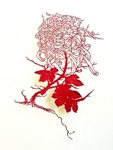


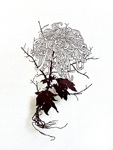
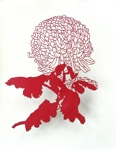
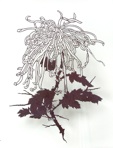

‘Phantasieblume’ was developed as a series of solo presentations at C4RD (London 2009), VANE Gallery (Newcastle 2010) and Hå gamle prestegard (Norway 2011). Dialogues between craft and innovation in contemporary fine art practice were explored through group drawing exhibitions at Fruehsorge Contemporary Drawings (Berlin), The Burton Art Gallery & Museum (Bideford) and Torrence Art Museum (LA).
‘Metatopia’, a work from this series, was awarded a Major Prize in the John Moores Contemporary Painting Prize (2010) and has since become part of the National Museums Collection (2012). It is currently on permanent display at Walker Art Gallery, Liverpool.
‘Phantasieblume’ was further contextualized and disseminated in an artist monograph (2010), which featured essays and text contributions by Philip Austander, Stephanie Brown, Paul Stone, Andrew Hewish, George Chakravarthi, Matthew Hearn and Clive Jennings. Funded by Newcastle University and ACE, partnered with the National Glass Centre, Art Editions North and Centre for Recent Drawing as part of the prestigious Documents for Recent Drawing series, the book was distributed internationally by Cornerhouse, Manchester. A second edition of the monograph was also produced in Prussian blue, with a limited signed Artists print (50 copies).

